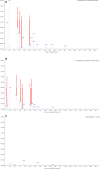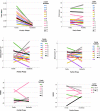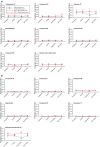Olfactory signals and fertility in olive baboons
- PMID: 33875713
- PMCID: PMC8055877
- DOI: 10.1038/s41598-021-87893-6
Olfactory signals and fertility in olive baboons
Abstract
Female primates signal impending ovulation with a suite of sexual signals. Studies of these signals have focussed on visual, and to a lesser extent, acoustic signals, neglecting olfactory signals. We aimed to investigate the information content of female olfactory signals in captive olive baboons (Papio anubis) and relate these to the female fertile period. We studied eight adult females living in four groups at the CNRS Station de Primatologie, Rousset-sur-Arc, France. We used vaginal cytology to detect ovulation. We investigated the volatile component of odour signals using solid-phase microextraction and gas chromatography-mass spectrometry. We found a total of 74 volatile compounds, of which we tentatively identified 25, including several ketones, alcohols, aldehydes, terpenes, volatile fatty acids and hydrocarbons that have been identified in odour profiles of other primates. Our results show that vaginal odour intensity differs with sexual cycle stage suggesting that odour might play a role in signalling female baboon fertility. We found differences in vaginal odour between females living in all-female and in mixed sex groups but we could not distinguish the effects of group composition, female age and identity. This study of olfactory signalling improves our understanding of how female primates advertise their sexual receptivity.
Conflict of interest statement
The authors declare no competing interests.
Figures








References
-
- Andersson M. Sexual Selection. Princeton University Press; 1994.
-
- van Schaik CP, van Noordwijk MA, Nunn CL. Sex and social evolution in primates. In: Lee PC, editor. Comparative Primate Socioecology. Cambridge: Cambridge University Press; 2000. pp. 204–240.
-
- Pagel M. The evolution of conspicuous oestrous advertisement in Old World monkeys. Anim. Behav. 1994;47:1333–1341. doi: 10.1006/anbe.1994.1181. - DOI
Publication types
MeSH terms
Substances
LinkOut - more resources
Full Text Sources
Other Literature Sources

